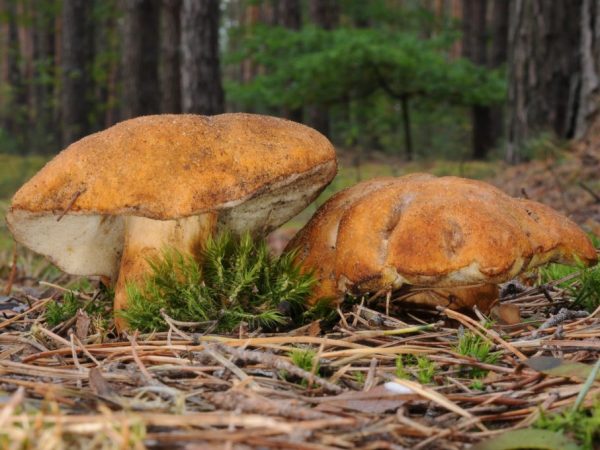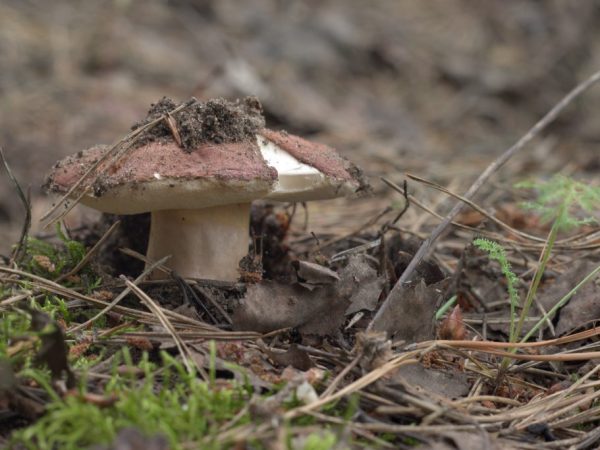Description of chestnut mushroom
Chestnut mushroom is an outwardly attractive mushroom and is edible. He has no poisonous counterparts.

Description of chestnut mushroom
Description
In Latin, the chestnut mushroom is called Gyroporus castaneus (chestnut gyroporus), and among the people - chestnut, hare or sand. Previously, this species belonged to the Boletovye family, the Gyroporus genus. To date, the Gyroporovid subfamily has been transformed into the Gyroporovy family. Outwardly, it looks like a porcini or Polish mushroom, it has the following description:
- in young specimens, the cap is convex, its size is 3-9 cm in diameter;
- the surface is velvety-fleecy;
- skin color is brown or beige;
- tubular hymenophore;
- spores are oval, ellipsoidal;
- spore powder white-yellow;
- brown leg is hollow inside, height up to 8 cm.
The older the organism, the less villi remain on its cap, what can you do, everyone becomes bald ... It can crack around the edges if the summer is dry. The cut of the pulp on the cap and stem does not darken. The old chestnut mushroom has a hollow tubular stem that is thickened towards its base. Its height depends on weather conditions, its height is from 3 cm to 8 cm.
The pulp of the chestnut mushroom is characterized by fleshiness and white color. It is fragile in a young organism, but the old hare mushroom has a hard and dry pulp.
Irina Selyutina (Biologist):
Indeed, initially the chestnut has a convex cap, but then it becomes flattened, thin, or almost smooth. The spongy layer (hymenophore) is finely porous, white or whitish. The leg is one-color along its entire length with a cap, even, without a ring ("skirt") - the remains of a private veil covering the hymenophore.
Grows in coniferous and deciduous (more often deciduous) forests. On the territory of the post-Soviet space, this species is more often found in the southern half of the European part, sometimes in the Volga region, Leningrad and Moscow regions, the Caucasus and the Far East. You can also find it in Europe, Asia (Japan), North America.
This rare forest species, chestnut mushroom, is included in the Red Book of Russia. It grows under broadleaf trees. Forms mycorrhiza with beeches, oaks and conifers.
Similar species
This mushroom or chestnut gyroporus has several similar species, edible and non-edible. Edible includes blue gyroporus (Gyroporus cyanescens), and poisonous - bile (Tylopilus felleus).
Gyroporus blue
Listed in the Red Book of Russia, it is known under several more names: bruise, birch gyropore. Description:
- the cap has a characteristic bulge;
- the size of the upper part is from 6 cm to 16 cm in diameter;
- the color is light yellow or grayish, with a brown tint;
- the skin is dry and velvety to the touch;
- the leg can be up to 10 cm high;
- inside the leg is hollow;
- the taste is pleasant, delicate, without bitterness.
At the break, the pulp has a characteristic blue or cornflower blue color, from which its name came. In young specimens, the leg is dense, thickened downward, and with age it becomes hollow and fragile.
Irina Selyutina (Biologist):
A bruise, or blue gyroporus, is characterized by a rather thick pale yellow leg without a ring, one-color with a cap (just under the cap - light). You can find a mushroom in forests and meadows. Able to form mycorrhiza with birch, chestnut, oak, and presumably with pine. Since this mushroom is often found in meadows, the question of mycorrhiza is open.
Creates mycorrhiza with birch and oak. It develops well on sandy soils, in a temperate climatic zone, bears fruit from mid-July to late September.
Gall mushroom

Mushroom is inedible due to bitter taste
Bile is the inedible counterpart of the chestnut gyroporus. Belongs to the genus Tilopilus (Tylopilus) from the Boletovye family. Fruiting from July to October, on sandy, light soils, in coniferous or mixed forests.
Description:
- cap size up to 12-14 cm in diameter;
- the shape of the "hood" is convex;
- skin color from brown to brown;
- the flesh is white and soft;
- on the cut, the flesh turns pink;
- the leg grows up to 10 cm;
- base diameter up to 3.5 cm;
- the color of the leg is pale beige;
- the taste of the pulp is bitter.
The white tubules of the hymenophore of young bile fungi, as it develops, become pale pink, dirty with age. Their aroma is weak, not pronounced. It tastes like quinoa.
The mushroom is considered inedible precisely because of its disgusting taste. However, some mushroom pickers soak it in salt water and then cook it. Experts from a number of Western countries, on the contrary, are sure that the gall fungus is poisonous and there are toxins in its pulp (even in small quantities), which, being absorbed into the bloodstream after eating it or even simply touching it, cause disturbances in the liver. which ultimately can lead to cirrhosis of this organ.
Beneficial features
Chestnut has a lot of useful properties due to its unique chemical composition, which includes fiber, natural protein, minerals, vitamins and trace elements. It has antioxidant effects due to the presence of theanine. Medicinal preparations based on the mushroom have the following beneficial properties:
- calm the nervous system;
- stabilize blood pressure;
- increase immunity;
- promote weight loss;
- help in the fight against cancerous tumors.
Polysaccharides and amino acids, which the forest organism contains, actively counteract the cells that cause the development of Ehrlich's carcinoma and sarcoma.
Contraindications and harm
Because of its bitter taste, this mushroom-double (bilious) people have long been nicknamed "gorchak". This property is a consequence of the release of toxic substances from the pulp, which, when they enter the human body, are quickly absorbed.
In severe cases, damage to the liver and gastrointestinal tract occurs. Symptoms appear the next day.
To avoid problems and to avoid poisoning, you should follow the safety rules when harvesting and preparing mushrooms. It is important for a mushroom picker not to forget the golden rule, or rule number 1 (call it what you want): Not sure what kind of mushroom it is - pass by.
Application
Chestnut mushroom preparations help with cerebral vasospasm and epilepsy.
The water tincture is used to treat joints and psoriasis. If necessary, decoctions are used as an emetic and antihelminthic agent.
Chestnut mushroom has a weak aroma and specific taste. To enhance the smell, it is subjected to heat treatment, it is more suitable for frying or cooking, as well as for drying, which reveals its qualities. It is not suitable for salting because of its bitter taste. Hares love him, hence the second name of the mushroom - hare.
Conclusion
A large and beautiful chestnut mushroom is considered a desirable prey for lovers of "quiet hunting" who know how to cook it properly. It is rare and grows in small groups. But it is better to pass by and not cut off this endangered species of forest organisms.In Russia, collecting them is prohibited by law and is considered poaching.



